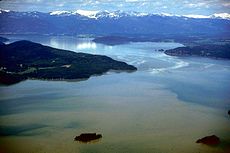| Lake Pend Oreille | |
|---|---|
 Aerial view in 1993 | |
| Location | Bonner / Kootenai counties, Idaho, U.S. |
| Coordinates | 48°10′0″N 116°20′0″W / 48.16667°N 116.33333°W |
| Primary inflows | Clark Fork River, Pack River, Trestle Creek |
| Primary outflows | Pend Oreille River, Spokane Valley–Rathdrum Prairie Aquifer[1] |
| Basin countries | United States |
| Max. length | 69 kilometres (43 mi) |
| Surface area | 380 km2 (150 sq mi) |
| Average depth | 142 m (466 ft) |
| Max. depth | 351 m (1,152 ft) |
| Water volume | 53.96 km3 (12.95 cu mi) |
| Surface elevation | 628 metres (2,060 ft) |
| Trenches | Purcell |
| Settlements | Sandpoint, Bayview |
Lake Pend Oreille (/ˌpɒndəˈreɪ/ POND-ə-RAY)[2] in the northern Idaho Panhandle is the largest lake in the U.S. state of Idaho and the 38th-largest lake by area in the United States, with a surface area of 148 square miles (380 km2). It is 69 kilometres (43 mi) long, and 1,152 feet (351 m) deep in some regions, making it the fifth-deepest in the nation and having a volume of 43,939,940 acre feet = 54 km3. The lake is fed by the Clark Fork River and the Pack River, and drains into the Pend Oreille River, as well as subsurfacely into the Spokane Valley–Rathdrum Prairie Aquifer.[1] It is surrounded by national forests and a few small towns, with the largest population on the lake at Sandpoint. The majority of the shoreline is non-populated and all but the southern tip of the lake is in Bonner County. The southern tip is in Kootenai County and is home to Farragut State Park, formerly the Farragut Naval Training Station during World War II, of which a small part is still active and conducts U.S. Navy acoustic underwater submarine research.[3][4]
The surrounding forests consist of ponderosa pine, Douglas fir, red cedar, poplar, quaking aspen, hemlock, paper birch and western larch.[5][6] Local animal species include white-tailed deer, elk, gray wolves, moose, mice, squirrels, chipmunks, black bears, grizzly bear, coyotes, mountain goat, cougar and bobcats, along with bald eagles, wild turkeys, osprey, owls, hummingbirds, hawks, woodpeckers, ducks, and the mountain bluebird. The lake is a home for several species of migratory water fowl.
- ^ a b "Ground-Water Flow Model for the Spokane Valley-Rathdrum Prairie Aquifer". United States Geological Survey. Retrieved December 3, 2018.
- ^ "Definition of pend oreille | Dictionary.com". www.dictionary.com. Retrieved 2020-06-29.
- ^ Geranios, Nicholas K. (August 23, 1998). "Small Submarines Test Silent, Test Deep in Mysterious Idaho Lake". Los Angeles Times. Associated Press. Retrieved January 10, 2022.
- ^ "Small Subs Provide Big Payoffs for Submarine Stealth". Archived from the original on 2013-03-13. Retrieved 2013-02-06.
- ^ "USDA". Retrieved 2021-09-28.
- ^ "Archived copy". Archived from the original on 2011-08-26. Retrieved 2012-08-12.
{{cite web}}: CS1 maint: archived copy as title (link)

